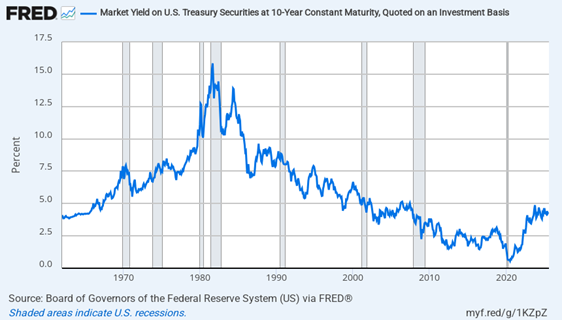Don't Let Recency Bias Block You In
-
 August 15, 2025
August 15, 2025
FOMC Update
The Federal Open Market Committee (FOMC) of the Federal Reserve Bank (Fed) met July 29-30 and kept the overnight Fed Funds target range at 4.25-4.50% for the fifth consecutive meeting. Two dissenting voters, the most since 1993, favored a 0.25% rate cut. The moderating economy, low unemployment, solid labor market conditions, and elevated inflation were the Fed’s rationale for maintaining the rate. Fed Chair Jerome Powell indicated in a follow-up press conference that a rate cut at the FOMC’s next meeting on Sept. 16-17 is an unlikely possibility.
The bond market’s reaction was muted with slightly increasing rates. Following the meeting, the Fed Funds futures market had a less than 50% likelihood of a rate cut priced in, opposed to 61% prior to the meeting. However, rate cut expectations for the September meeting rose to over 80% with the weaker-than-expected employment report and significant downward revisions to the May and June reports where over 280,000 jobs were revised away on Friday, August 1.
“Modestly Restrictive”
Fed Chair Jerome Powell described the current interest rate policy as “modestly restrictive.” The Fed classifies its interest rate policy in three categories:
- Restrictive: Slows economic activity and reduces inflationary pressures in the domestic economy
- Neutral: Neither restricts nor stimulates the domestic economy
- Accommodative: Stimulates the domestic economy
The Fed’s economic projections currently place the long-term neutral rate at 3.0% with a 2.0% long-term inflation target, resulting in a 1.0% real yield over inflation. However, this neutral rate has fluctuated, and it is unlikely the Fed Funds rate will settle at the long-term rate as the Fed board changes members over time.
Looking Back at Historical Fed Funds Rates
According to the St. Louis Federal Reserve Bank’s FRED database, the Fed Funds rate has varied significantly over the last 70+ years.
Effective Fed Funds Rate (month-end data) – July 1954 to Present.
The average rate during this time frame is around 4.6% with a high of 19.04% in July 1981 and a low of 0.05% from April-May 2020. The current rate of 4.33% is slightly below the average unless excluding the almost-zero rate periods of the 2010’s and 2020-2021, in which it is substantially below average.
The Fed controls short-term borrowing rates by virtue of the Fed Funds Rate. However, most long-term loan rates such as home mortgages are more influenced by the 10-year U.S. Treasury (UST) rates.
Interest Rates on 10-Year U.S. Treasury Bond (month-end data): 1962 to Present.
The average interest rate for the 10-Year UST over the past 63 years is 5.85% with a high of 15.84% in September 1981 and a low of 0.55% in July 2020. The current yield is 4.34%, which is substantially below the long-term average unless excluding the 1970s and 1980s peak rates, in which it would be in line with the long-term average.
What Does This Mean?
It is essential to avoid recency bias, or prioritizing importance of recent events over historical events. The adage, “history doesn’t repeat itself, but it often rhymes” is a reminder to ensure long-term decisions aren’t based on short-term conditions. Make certain your farm business does not rely on lower interest rates to be successful.
While the market anticipates the Fed to lower its rate over the next year, the pace of those rate reductions is uncertain. Keep in mind the current interest rate environment is not abnormally high by historical standards. The market anticipates short-term rates will trend lower, but longer-term rates may not follow in lockstep. Plan to manage your interest rate risk with the adjustable and fixed interest rate products available. We indeed live in INTEREST-ing times!
-
Tag Cloud
Essentials Newsletter Land Values Financials security liquidity Community Improvement Grants land sales Dr David Kohl Education Farm farmland auctions scholarships Weather Outlook Calendar contest patronage balance sheet Focus on Farming calendar appraisals cash flow Weather employees FOMC Farm Credit College rural marketplace investment Auction Results 4-H Land Classes Interest Rates FFA



